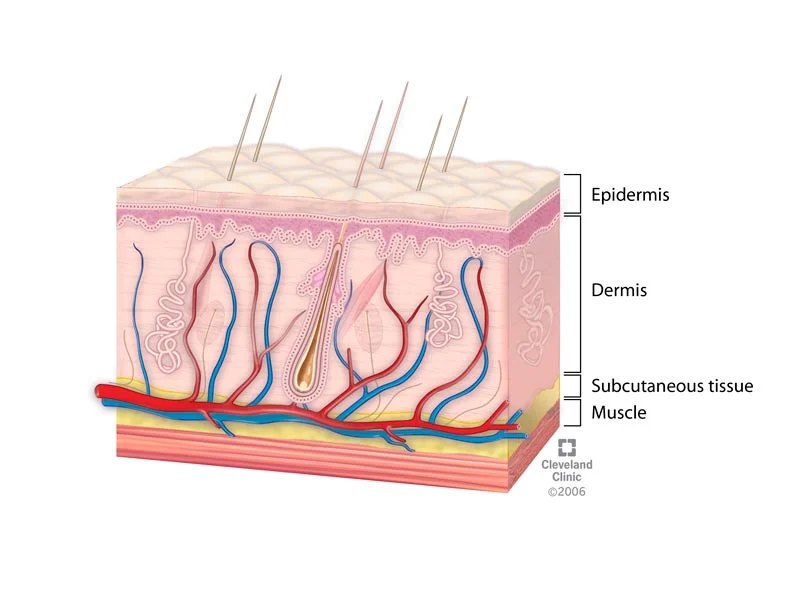What Is The Integumentary System? Skin Disorders And Protection

The integumentary system is a vital component of the human body that serves as a protective barrier between the internal organs and the external environment. This system consists of the skin, hair, nails, and glands, all of which work together to maintain the body’s homeostasis.
The skin, which is the largest organ in the body, is the primary component of the integumentary system and serves as the first line of defense against injury, infection, and environmental factors.
The integumentary system is a complex network of structures that play a crucial role in protecting the body and maintaining its overall health. Understanding the anatomy and functions of this system is essential in identifying and treating a range of skin disorders that can affect people of all ages.
In this article, we will delve into the intricacies of the integumentary system, its three layers, and the functions of the skin. We will also discuss some common skin disorders, including their causes, symptoms, and treatment options, as well as provide tips and best practices for protecting your skin from damage.
Key Takeaways
- The integumentary system is made up of skin, hair, nails, and glands, and serves as a protective barrier between the body and the environment.
- The skin is the largest organ and has three layers: epidermis, dermis, and subcutaneous tissue, which work together to regulate temperature, provide sensory information, and act as a barrier against injury and infection.
- Common skin disorders include acne, eczema, psoriasis, rosacea, and dermatitis, and can be caused by genetics, lifestyle, and environmental factors.
- Protecting the skin can be done by wearing protective clothing, using sunscreen, avoiding harsh chemicals, and moisturizing regularly, while seeking professional advice is important for managing skin disorders.
Understanding the Anatomy of the Skin
The skin is composed of three main layers: the epidermis, dermis, and subcutaneous tissue, each with its unique structure and function.
The epidermis is the outermost layer of the skin and is primarily composed of keratinocytes, which produce the protein keratin that makes the skin tough and waterproof. This layer also contains melanocytes, which produce the pigment melanin that gives the skin its color and protects it from the harmful effects of the sun’s ultraviolet radiation.
The dermis is the middle layer of the skin and is composed of collagen and elastic fibers that give the skin its strength and elasticity. This layer also contains blood vessels, nerves, and sweat and oil glands, which help regulate body temperature and keep the skin moisturized.
The subcutaneous tissue is the deepest layer of the skin and is composed of fat cells that provide insulation and padding to the body.
Understanding the anatomy of the skin is essential in diagnosing and treating skin disorders, as well as protecting it from harmful environmental factors.
The Three Layers of the Integumentary System
Composed of three distinct layers, this vital bodily covering serves as a barrier between the internal and external environments, regulating temperature and preventing dehydration while also providing sensory information to the brain. These three layers, in descending order, are the epidermis, dermis, and subcutaneous tissue.
- The epidermis is the outermost layer of the skin and is primarily composed of keratinocytes, which produce the protein keratin that forms a protective barrier against environmental factors such as UV radiation and chemical exposure. It also contains melanocytes that produce melanin, which helps to protect the skin from UV radiation and gives skin its color. Additionally, the epidermis contains Langerhans cells that play a role in the immune response.
- The dermis is the middle layer of the skin and contains a variety of structures such as hair follicles, sweat glands, and blood vessels. It is composed of collagen and elastic fibers that provide strength and elasticity to the skin. The dermis also contains nerve endings that provide sensory information such as touch, pressure, and pain.
- The subcutaneous tissue is the deepest layer of the skin and is composed of fat cells that provide insulation and cushioning to the body. It also contains blood vessels and nerves that supply the skin and underlying tissues.
Understanding the three layers of the integumentary system is crucial in identifying and treating skin disorders and injuries. Each layer serves a specific function and plays a vital role in protecting the body from external factors and regulating internal temperature. Any damage or disruption to these layers can lead to various skin conditions and affect the overall health of the body.
Functions of the Skin: Protection, Sensation, and Temperature Regulation
Functioning as a vital bodily covering, the skin serves to regulate internal temperature, provide sensory information to the brain, and act as a barrier against environmental factors. The skin is composed of three main layers: the epidermis, the dermis, and the hypodermis. Each layer has a unique function that contributes to the overall health and protection of the body.
One of the primary functions of the skin is temperature regulation. The skin contains sweat glands that produce sweat, which helps to cool the body down when it becomes overheated. Additionally, the skin contains blood vessels that constrict or dilate to regulate blood flow and heat loss. Sensation is another important function of the skin. The skin is covered in sensory receptors that allow us to feel sensations such as touch, pressure, and pain. This sensory information is sent to the brain, which helps us to navigate the world around us. Finally, the skin acts as a barrier against environmental factors such as bacteria, viruses, and pollutants. The skin’s outermost layer, the epidermis, is composed of tightly packed cells that prevent harmful substances from entering the body.
| Function | Description | Example | ||||
|---|---|---|---|---|---|---|
| Temperature Regulation | Sweat glands produce sweat to cool the body down when it becomes overheated. | Sweating during exercise | ||||
| Sensation | The skin is covered in sensory receptors that allow us to feel sensations such as touch, pressure, and pain. | Feeling a hot stove and quickly pulling away | ||||
| Barrier Function | The skin’s outermost layer, the epidermis, is composed of tightly packed cells that prevent harmful substances from entering the body. | Preventing bacteria from entering a cut in the skin | ||||
| Vitamin D Synthesis | The skin produces vitamin D when exposed to sunlight. | Getting vitamin D from spending time in the sun | ||||
| Absorption | The skin can absorb certain substances such as medications. | Applying a topical cream to the skin | Protection | The skin acts as a barrier to protect internal organs and tissues from physical damage and harmful environmental factors. | Wearing protective clothing and using sunscreen can help protect the skin from damage. |
Common Skin Disorders and Their Causes
Various factors can trigger skin conditions that cause discomfort and affect one’s quality of life. These skin disorders can be caused by various factors such as genetics, lifestyle, and environmental factors.
One of the most common skin disorders is acne, which is caused by excess oil production, bacteria, and clogged pores. Acne affects millions of people worldwide, and it can lead to scarring, hyperpigmentation, and even depression.
Other common skin disorders include eczema, psoriasis, rosacea, and dermatitis. These conditions can be caused by various factors such as stress, allergies, and hormonal imbalances.
Eczema is characterized by dry, itchy, and inflamed skin, and it can be caused by genetics, allergies, and environmental factors.
Psoriasis is an autoimmune disorder that causes red, scaly patches on the skin, and it can be triggered by stress, infections, and injuries.
Rosacea is a chronic skin condition that causes redness, swelling, and acne-like bumps on the face, and it can be caused by genetics, sun exposure, and alcohol consumption.
Dermatitis, on the other hand, is a general term for skin inflammation, and it can be caused by various factors such as irritants, allergens, and infections.
To treat these skin disorders, it is important to identify the underlying cause and address it accordingly.
Acne: Types, Triggers, and Treatment Options
Acne is a prevalent skin condition that affects people of all ages, genders, and races. It occurs when hair follicles become clogged with oil and dead skin cells, leading to inflammation and the development of pimples, blackheads, and whiteheads. Excess oil production, bacteria, hormonal changes, and genetics are some of the factors that can trigger acne.
The condition can occur on different parts of the body, including face, neck, chest, and back, and can cause discomfort and affect the appearance of the affected area. There are different types of acne, including mild, moderate, and severe, and each requires a specific treatment approach.
Mild acne can be managed using over-the-counter products, such as benzoyl peroxide and salicylic acid, which help to unclog pores and reduce inflammation. Moderate to severe acne may require prescription medications, such as antibiotics, retinoids, and hormonal treatments, which aim to control bacteria, reduce inflammation, and regulate oil production.
In some cases, acne can leave scars and pigmentation, which may require additional treatments, such as laser therapy and chemical peels. Therefore, it is important to seek professional advice from a dermatologist to determine the most appropriate treatment plan for managing acne.
Eczema: Symptoms, Triggers, and Prevention Techniques
Eczema, a chronic skin condition characterized by dry, itchy, and inflamed skin, affects millions of people worldwide and can significantly impact their quality of life. While the exact cause of eczema is not fully understood, it is believed to be a combination of genetic and environmental factors.
Here are three things to know about eczema:
- Symptoms: The most common symptoms of eczema include dry, itchy skin, redness, inflammation, and sometimes blistering or oozing. These symptoms can occur anywhere on the body but are most commonly found on the face, neck, hands, and feet.
- Triggers: Eczema symptoms can be triggered by a variety of factors, including stress, allergens such as pollen, pet dander, or certain foods, harsh soaps or detergents, and changes in temperature or humidity.
- Prevention Techniques: While there is no cure for eczema, there are several techniques that can help prevent flare-ups. These include using gentle soaps and moisturizers, avoiding known triggers, wearing soft, breathable clothing, and managing stress levels. In some cases, topical or oral medications may also be prescribed to help manage symptoms.
Psoriasis: Types, Triggers, and Management Strategies
Psoriasis is a chronic autoimmune disorder that affects approximately 125 million people worldwide. The condition causes the immune system to attack healthy skin cells, leading to the development of red, inflamed, and scaly patches on the skin.
The patches can appear anywhere on the body, but they are most common on the scalp, elbows, knees, and lower back. In some cases, psoriasis can also affect the nails, causing them to become thick, discolored, and ridged.
There are several types of psoriasis, including plaque psoriasis, guttate psoriasis, inverse psoriasis, pustular psoriasis, and erythrodermic psoriasis. Each type has its unique characteristics, and the severity of the condition can vary from person to person.
While the exact cause of psoriasis is unknown, it is believed to be related to a combination of genetic and environmental factors. There is no cure for psoriasis, but there are several management strategies that can help reduce symptoms, including topical creams, light therapy, and oral medications.
Protecting Your Skin from Damage: Tips and Best Practices
Psoriasis is indeed a difficult skin condition to manage, as it can be triggered by various factors. However, it is important to remember that psoriasis is not the only skin condition that requires attention and care. In fact, protecting our skin from damage should be a priority for everyone.
This brings us to our current subtopic: ‘Protecting Your Skin from Damage: Tips and Best Practices’. To start with, it is important to note that there are several factors that can damage our skin, including the sun, pollution, harsh chemicals, and even certain fabrics. Therefore, it is crucial to take steps to protect our skin from these factors.
Here are some tips and best practices to consider:
- Wear protective clothing: When outdoors, it is important to wear clothing that covers your skin, such as long-sleeved shirts and hats.
- Use sunscreen: Sunscreen is a crucial tool in protecting our skin from the harmful rays of the sun. Make sure to choose a sunscreen with at least SPF 30 and apply it generously.
- Avoid harsh chemicals: Certain chemicals found in household cleaning products and skincare products can damage our skin. It is important to read labels and avoid products with harsh chemicals.
- Moisturize: Keeping our skin moisturized is key in protecting it from damage. Choose a moisturizer that is free from harsh chemicals and apply it daily.
Conclusion
The integumentary system plays an essential role in protecting the body from external factors such as harmful chemicals, extreme temperatures, and physical injuries. By understanding the anatomy of the skin and its three layers, we can appreciate the functions of the integumentary system, including sensation, temperature regulation, and protection.
However, skin disorders such as acne, eczema, and psoriasis can affect the skin’s health and appearance. Acne is a common skin disorder that affects millions of people worldwide. It is caused by overproduction of sebum, which clogs the pores and leads to inflammation. Eczema is a chronic skin condition characterized by red, itchy, and inflamed patches on the skin. Psoriasis is an autoimmune disease that causes the skin to form thick, scaly patches. While there is no cure for these conditions, various preventative measures, lifestyle changes, and treatment options can help manage the symptoms.
To protect your skin from damage, it’s essential to follow best practices such as avoiding direct sun exposure, staying hydrated, and using suitable skin care products. By adopting these practices, we can maintain healthy skin and reduce the risk of skin disorders.
In conclusion, the integumentary system is a complex and fascinating system that plays an essential role in protecting our bodies. By taking care of our skin and seeking medical attention when necessary, we can ensure that our skin remains healthy and functional.









